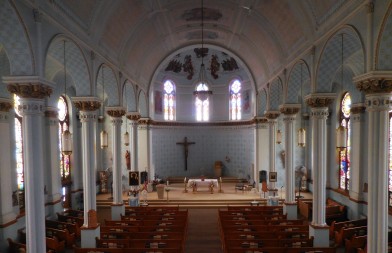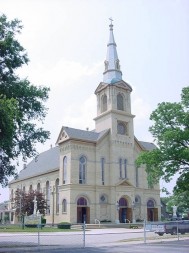May 30, 2017 // Diocese
In MY diocese: St. Hedwig’s rich Polish tradition
St. Hedwig has been a fixture of downtown South Bend for well over a century. A unique feature of the church is its strong Polish heritage, which is still present today.
“I always tell anyone who’s Polish that if you want a good Polish Mass, you go to St. Hedwig because the flavoring is very thick and strong over there,” said Rose Burns, who is the parish secretary for both St. Hedwig and St. Patrick.
The “flavoring” comes from the many Polish customs that the parish continues to do today. One of the most obvious examples are the Polish hymns that the congregation sings during Mass on Saturday and Sunday.
Another example is St. Hedwig’s annual parish festival, which usually features a variety of popular Polish dishes including golabki, a cabbage roll stuffed with ground beef and rice, and pierogis, which are dough pockets that are often stuffed with either sauerkraut, cheese, mashed potatoes or even fruit. At the festival there’s also dancing, and many parishioners will even attend wearing traditional Polish dresses.
“It’s are very much a Polish parish,” said Rose Ann Benassi, who is the business manager for St. Hedwig. “They love their tradition, and they fight for it. If a priest comes in and tries to take something away, they’ll let him hear about it.”
Some of the traditions the parish community has fought to keep in the past are the blessing of the food on Easter, and making sure that midnight Mass on Christmas did not get moved to 11 p.m.
However, the majority of the very traditional parishioners are elderly, so the rich tradition at the parish is in jeopardy.
“I’m Polish but I wouldn’t fight for it and kids don’t get to see the tradition because a lot of them don’t go to church,” said Benassi. “The traditions are just going to die off, unfortunately.”
That’s too bad, because the tradition and the church are both very beautiful; but the good news is that downtown South Bend has been in the midst of a revival in recent years, which hopefully will bring more parishioners to St. Hedwig who can help carry on its Polish heritage.
History
St. Hedwig was founded in 1977 and is considered to be the mother parish of the South Bend Polish community.
It was established because of the large Polish migration to the South Bend area that took place in 1863, after Poland’s unsuccessful uprising against the Russian Empire. Initially, the local Polish community attended St. Patrick, which to this day is located across the street from St. Hedwig; but it wasn’t long before they decided to build their own parish.
Today the parish belongs to the Diocese of Fort Wayne-South Bend, but it was founded under the direction of the Congregation of Holy Cross.
Father Walenty Czyzewski, CSC, was the parish’s first pastor, and he served until his death in 1913. Under his guidance other Polish parishes were established in the area, including several that are still in the South Bend area today, such as St. Stanislaus on Brookfield Street and St. Adalbert on Grace Street.
From the beginning the parish had an elementary school, which was open until 1967. In 1928, St. Hedwig High School opened, which was renamed South Bend Catholic High School in 1936. Then, in 1953, it evolved into South Bend’s Saint Joseph High School.
Dedicated in 1883, St. Hedwig is the oldest church building in South Bend. The Romanesque style church stands at 156-foot-tall and contains many vibrant and colorful stained glass windows. The church has been renovated several times, including in 1989 and 1998.
St. Hedwig
331 S. Scott St.
South Bend, IN 46601
574-287-8932
Mass Times:
Sunday: 9 a.m.; Last Sunday of the month 5 p.m. in Vietnamese
Saturday: First Saturday 8 a.m.;
4 p.m.
Weekday: Mon., Tues. 12:15 p.m.
Reconciliation:
M-F 10 a.m.-noon at St. Hedwig Rectory; Sat. 3 p.m. at St. Hedwig or by appointment.
____________________
St. Patrick, St. Hedwig: two parishes under one pastoral staff
Since 2001, two of South Bend’s oldest parishes have been under the direction of one pastoral staff.
Over 16 years ago, the Most Reverend Bishop John D’Arcy combined St. Patrick and St. Hedwig, which are located in downtown South Bend, right across the street from each other.
“The parishes decided to combine rather than having two different priests,” said Father Cyril Fernandes, the pastor at both parishes. “There was a lack of priests, so the bishop thought it was the best to combine them under one pastor and an associate pastor.”
The number of families at each parish had also decreased significantly as parishioners migrated to rural areas, making the communities small enough to managed by one staff.
Given the church’s proximity to one another, the decision to combine may seem like an easy choice: but historically, St. Patrick, which was founded by Irish immigrants, and St. Hedwig, which was founded by Polish immigrants, were in opposition of one another.
“It was taken down long ago, but in the beginning St. Patrick had a fence built between the parishes, and they wouldn’t let any of the Polish to cross it,” said Rose Burns, the parish secretary for both churches. By the time the two parishes were combined the feud between them had been over for years, but there have still been difficult moments getting them to come together.
Father Leonard Chrobot was the first pastor given the responsibility of both parishes. He had been the pastor of St. Hedwig since 1995, before he was also put in charge of St. Patrick in 2001. Following Father Chrobot was Father Fernandes, who has been the pastor of both parishes for the past four years.
“It was difficult to bring the parishes together when I came here four years ago. The Polish and Irish are very traditional,” said Father Fernandes. “I think they are slowly getting together.”
An integral part of bringing the two parishes together has been the events that put the parishioners in a situation where they have to work together. There are even a handful of people who will willingly volunteer for fill a need, or help with a project, at either one.
“I call them the ‘Pat-wig Group’ because they help at St. Hedwig and at St. Patrick,” said Burns.
Another unique aspect of the pastoral staff is that its parochial vicar is from the Congregation of Holy Cross
“It’s not something that’s very regular,” said Father David Kashangaki, CSC, who is the current parochial vicar at the parishes. “But I came back from overseas in 2010 and I was looking for something to do. The bishop asked my provincial if he could assign me as the parochial vicar, and I’ve been here ever since.”
Also helping out is retired priest Father Camillo Tirabassi, who lives at the St. Hedwig rectory during the summer and fall.
Masses have been divided up between the two parishes. St. Hedwig has a Saturday Mass at 4 p.m., a Sunday Mass at 9 a.m., a Vietnamese Mass on the last Sunday of the month at 5 p.m.; and weekday Mass on Monday and Tuesday at 12:15 p.m.
St. Patrick has Sunday Mass at both 10:30 a.m. and 5:30 p.m., and weekday Mass Monday-Friday and first Saturday of the month at 8 a.m. Confession can be heard every weekday at the St. Hedwig rectory from 10 a.m. to noon, and on Saturdays at St. Hedwig from 3 p.m. to 4 p.m.
The best news. Delivered to your inbox.
Subscribe to our mailing list today.







